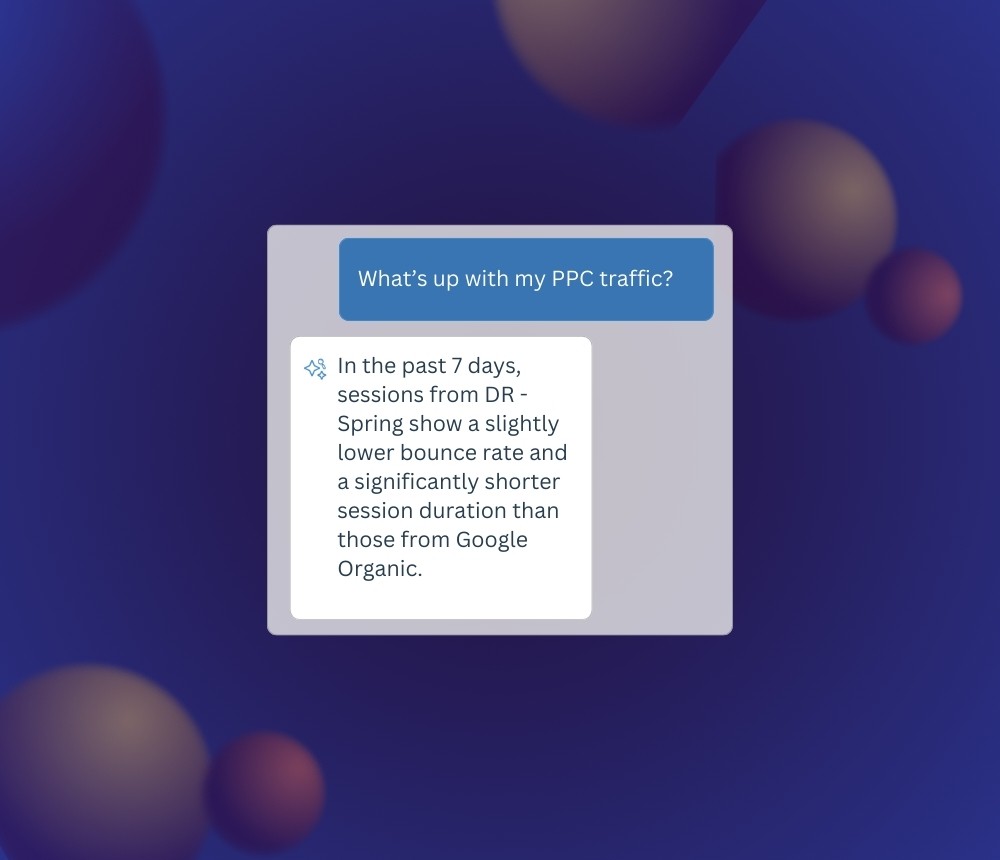Where Lucky Orange Fills In Google Analytics Gaps

Among web analytics tools, Google Analytics (GA) is commonly seen as the industry leader—providing comprehensive insights into user acquisition, behavior and conversion metrics.
It excels in mapping the start and endpoint of a user's journey, offering a broad view of how visitors arrive at and exit from a website. However, it falls short in revealing the intricacies of the visitor experience between these points.
This is where Lucky Orange comes into play, acting as a vital complement to Google Analytics.
While its latest edition, GA4, gives a macro perspective on traffic and campaign success, it often leaves website teams questioning the deeper "why" behind user actions—why visitors bounce from a certain page, why they abandon carts, or why engagement dips at specific junctures.
For instance, when analyzing traffic from an Instagram ad, Google Analytics can show the number of clicks; however, understanding what happens next requires a more nuanced approach. Lucky Orange enables marketers to see that while an ad may attract users with a blue fuzzy chair, their on-site behavior—such as searching for and purchasing the chair in pink—can offer unexpected insights into consumer preferences and decision-making processes.
Understanding Lucky Orange’s Role In Optimization
While Google Analytics is excellent for quantitative insights, Lucky Orange steps in to provide the qualitative and behavioral analysis needed to fully understand visitor behavior.
Lucky Orange data goes beyond what Google Analytics can provide, showing not just where users go but how they navigate and engage with your content. For example, you can see if users are clicking on non-interactive elements, indicating possible user confusion, or if they are scrolling past important information without engaging with it.
Imagine a scenario where your e-commerce site has a high exit rate on its product pages. GA highlights this issue but doesn’t explain why it's happening. Using Lucky Orange, you discover through session recordings that users struggle to find product details because the information is placed below the fold. Heatmaps further reveal that users often try to click on non-clickable product images, expecting more pictures or details.
Making targeted improvements, informed by qualitative data, can significantly enhance user experience, reduce exit rates and increase conversions.
Seamless Integration Between Lucky Orange and Google Analytics
One of the most powerful aspects of using Lucky Orange alongside Google Analytics is their seamless integration. Events set up in Lucky Orange will directly pass to your Google Analytics events, and vice versa. This bi-directional integration means that any event you create in one tool will automatically be tracked in both, allowing you to monitor them side-by-side without any additional setup.
Here's how the Lucky Orange + Google Analytics integration enhances your analytics capabilities:
Simplifies Event Management: When you create an event in Lucky Orange—such as tracking clicks on a specific button or form submissions—it will automatically appear in Google Analytics. This seamless synchronization ensures that all your key metrics are consistently tracked across both platforms.
Unified Data View: The integration provides a unified view of your data, combining the quantitative insights from Google Analytics with the qualitative insights from Lucky Orange. This holistic perspective helps you better understand user behaviors and the reasons behind them.
Enhanced Reporting: With events being tracked simultaneously in both tools, your reports become more comprehensive. Google Analytics can provide the broader context while Lucky Orange offers the granular details of user interactions.
Effortless Setup: Setting up this integration is straightforward, making it accessible even for those without extensive technical expertise. This ease of use ensures that you can quickly leverage the full potential of both tools without a steep learning curve.
Here’s how you can use both tools together:
Identify Problem Areas
Start with Google Analytics to pinpoint pages with high exit rates, low conversion rates, or significant drop-offs in the user journey. For example, if GA4 shows a high bounce rate on a specific landing page, this signals a potential issue.
Deep Dive with Lucky Orange
Once you've identified these problem areas, use Lucky Orange to understand why these issues are occurring. Watch session recordings to see exactly how users interact with those pages. Are they getting frustrated with a particular form or survey? Are they missing key calls-to-action?
Validate Hypotheses
Use heatmaps to confirm your assumptions from the session recordings. If many users are clicking on non-interactive elements, it may indicate that those elements need to be clickable or more clearly defined.
Take Action
Implement changes based on the insights from Lucky Orange and monitor the impact using Google Analytics. This iterative process helps ensure that your website continually improves in response to actual user behavior.
This kind of insight is invaluable—it helps you understand user preferences and potentially adjust your marketing strategy to highlight the most popular products more prominently.
What Quantitative Analytics Don’t Tell You
Reasons Behind High Exit Rates
Google Analytics can identify pages with high exit rates but doesn't provide insights into why users are leaving. For example, GA might show that your checkout page has a significant drop-off rate, but it won't reveal whether this is due to confusing navigation, slow load times, or complicated forms.
User Confusion Points
While GA can tell you which pages are popular or which pathways users take, it won't indicate areas where users might be getting confused. If users repeatedly click on non-interactive elements or struggle to find essential information, GA data alone won't capture this frustration.
Engagement with Non-Clickable Elements
Heatmaps and session recordings can show if users are interacting with parts of your site that aren’t clickable, indicating a potential design flaw. GA lacks this level of detail, making it harder to understand these subtle yet critical user interactions.
Mobile Usability Issues
GA can highlight if mobile users are not converting as well as desktop users, but it won't illustrate specific usability issues that mobile users might face. Problems like touch targets being too small, text being hard to read, or important buttons being off-screen are invisible to GA's metrics.
Content Effectiveness
GA provides data on page views and time spent on pages but lacks context on how users perceive and interact with your content. Are users engaging with your videos? Are they reading through your articles, or just skimming? GA's data can't answer these questions.
Complexity of Google Analytics
For someone just starting out in the world of web analytics, Google Analytics (GA) can be a powerful but intimidating tool.
GA offers a wealth of data and insights, but its complexity often requires extensive training to harness its full potential. Google even offers certifications to ensure users understand how to navigate its features and interpret its data correctly.
Conclusion
Combining the comprehensive data analysis of Google Analytics with the intuitive, user-friendly insights of Lucky Orange offers a powerful approach to understanding visitor behavior and enhancing website performance.
This dual strategy allows you to gain a deeper, more complete picture of how visitors interact with your site, identifying both quantitative trends and qualitative experiences. By leveraging the strengths of both platforms, you can unlock deeper insights that drive better results for your online presence.
In conclusion, while Google Analytics provides a foundation of performance metrics, Lucky Orange fills in the much needed gaps by offering detailed insights into visitor behavior and website performance. Together, they offer a complete view of your website’s effectiveness and areas for improvement, making it easier to enhance user experience and drive conversions.



